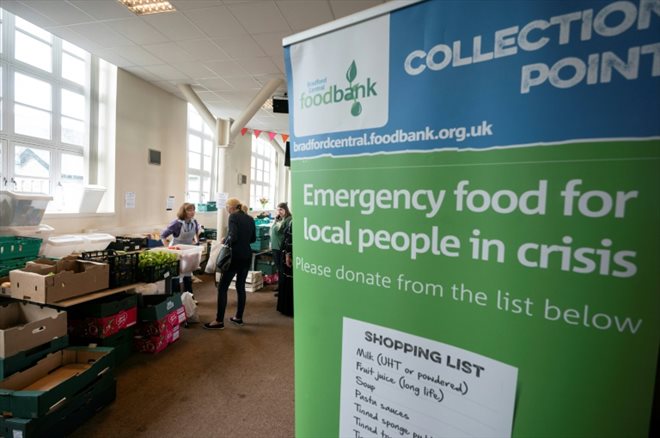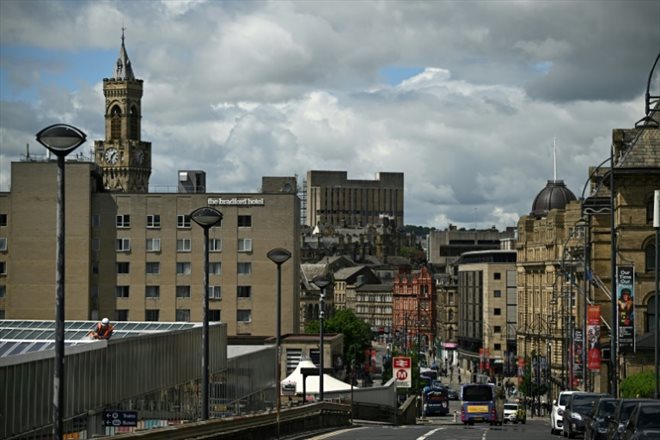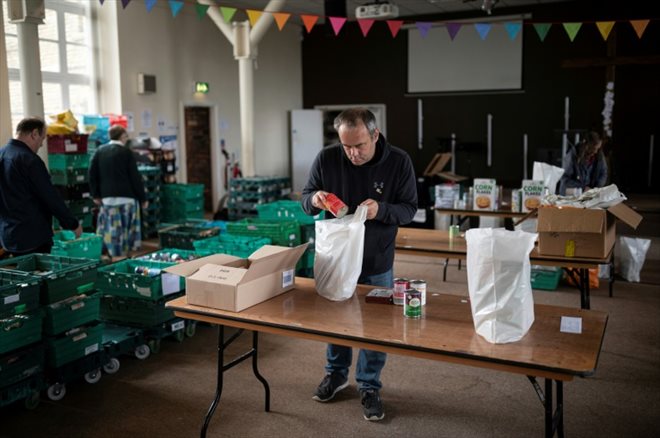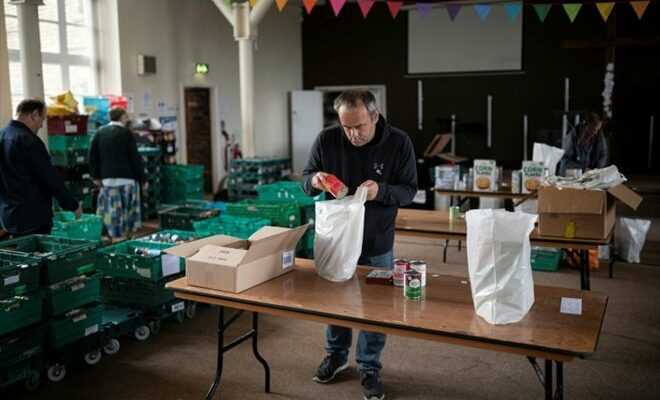Volunteers distribute food, including fresh produce, in Bradford, northern England, on May 24, 2022 (AFP/OLI SCARFF)
Under overcast morning skies in Bradford, northern England, a steady stream is heading towards the food bank, driven by the worst cost-of-living crisis in decades, raising fears of a devastating winter.
The food bank in the former industrial city of 500,000 inhabitants has twice as many beneficiaries as before the pandemic.
“Since I have been a volunteer, the numbers have only multiplied”, notes Karl Carroll, 33, beneficiary in 2019 before offering his help. “I have barely 40 pounds (47 euros) left once I’ve paid everything,” he told AFP.
Simon Jackson, 43, an unemployed ex-supermarket employee who receives health benefits, has been coming since February: “It’s hard right now…”.

Volunteers distribute food, including fresh produce, in Bradford, northern England, on May 24, 2022 (AFP/OLI SCARFF)
Once all the bills have been paid, there is not much left of the £900 monthly allowance he receives for food. Rising prices only make things worse.
“Places like here (…) save lives”, and “really help to make decisions, sometimes between heating and food”, he explains.
– Survival –
According to the Trussell Trust charity, its more than 1,400 affiliated sites distributed 2.1 million parcels during the past year – including 830,000 for children – 14% more compared to the pre-pandemic period.

View of the disadvantaged city of Bradford in terms of income and jobs, on May 24, 2022, in the north of England (AFP/OLI SCARFF)
In central Bradford, distributions take place three times a week, and are limited to three parcels every six months to meet demand.
There are basic products: cereals, soup, canned, pasta, vegetables, biscuits, sugar, tea or coffee.
Existing since 2011, the distribution point is one of thirty in the city. It has a thousand beneficiaries a month, according to director Josie Barlow.
The population of the conurbation, the sixth in England, is the fifth most deprived in terms of income and the sixth worst in terms of employment, according to the latest government index of poverty, published in 2019.
“It’s those who earn the least who will suffer the most…they have to buy basic commodities, which have increased enormously,” said Ms Barlow.
She welcomes new arrivals full of energy and with a smile on her face, directing them to the collection tables, but also to the advisers.

A bag full of food ready to be distributed in Bradford, May 24, 2022 in the north of England (AFP / OLI SCARFF)
“We want to give a food parcel, but we also really want to help people deal with the causes of their difficulties,” she explains.
She sees, she says, a “slice of society”, where the unemployed and employees rub shoulders.
For them, “there is really no way out”, she insists, “we cannot let people live like that, in crisis, just to survive in the long term”.
– “Additional coverage” –
After weeks of dithering, Boris Johnson’s government announced £15bn of support for the most vulnerable on Thursday, ahead of a 42% rise in energy bills expected in October, following a 54% rise the last month.
Not enough to allay fears that the worst is yet to come. Inflation, already at 9% and expected to rise even higher in the coming months, will swallow up any additional aid.

A volunteer prepares bags of food in Bradford, northern England, on May 24, 2022 (AFP/OLI SCARFF)
“I’m afraid of the coming winter”, underlines the head of the food bank, “I really don’t know how people will survive”.
Beneficiary Simon Jackson, fears the worst for Christmas: “not so much for me, because I’m alone, I’ll just put an extra blanket”, “but for those who have children (…) it’s going to be really hard” .
Simone Hillhands, 34, has three children, aged 10, 13 and 15. One of them has a disability that prevents the mother from working full time. It was the school that referred her to the food bank.
Reluctant to expand on her situation, she confides that her sister recently found herself on the street and that the family is in a “very, very difficult” situation with the rise in prices.
“They exploded, it’s crazy!”, She notes, adding that despite the pandemic, “last year was much easier”.
© 2022 AFP
Did you like this article ? Share it with your friends with the buttons below.




